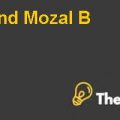
Midland Energy Resources Inc.
Overall Summary
Midland Energy Resource is involved in exploration, extraction and development oil products. Midland has three projects that are operating as its cost centers and are engaged in a range of oil related products. Each division’s capital structure and industry risk are different; therefore, a different cost of capital should be used for the appraisal of its capital investment decisions. Therefore, the management is concerned about the cost of capital for each division because the calculation of cost of capital is very much complex and sophisticated. In addition to this, cash flows from international projects are also discounted using the cost of capital of the company that is making from its own country, meanwhile, the economic value added is also a useful technique, which charges the overall profits by a notional charge equal to the cost of capital. Furthermore, the optimal capital structure also leads to the higher weighted averted cost of capital and the decision to repurchase its share depends on the intrinsic value that will be generated by comparing the company, however, the intrinsic value has been calculated by discounting the cash flows of different projects and a wrong decision would lead to the loss of an organization..
However, the cost of capital is final product of cost of equity and cost of debt, meanwhile, the cost of equity is calculated using three different variables of risk free rate that is based on the Treasury bill rate of similar maturity date and market risk premium is based on the market risk premium spread and the risk free rate , meanwhile, beta values are calculated using competitors’ data available in the market after ungearing the beta and re-gearing the industry beta with Midland gearing ratio of each division. Furthermore, the cost of debt is calculated using the risk free rate of similar treasury bonds. At the end, the cost of equity and cost of debt are combined according to the weight-age of the cost of debt based cost of equity.
Introduction
Midland Energy Resource (Midland) is a 120 year old company that operates in oil exploration and refinery industry, however, over a period of more than one century it has enjoyed great success and growth in exploration and refinery industry. Currently, Midland is vertically integrated with three of its divisions through which the production process is completed. In addition, exploration and production division has been a profitable division and it generated the profit margins of 56% in the year 2006. Since, the prices of oil are at their highest level and exploration industry is expected to grow in future; hence, Midland is expecting a capital expenditure of around $8 billion to meet the expansion needs. On the other hand, refining and marketing division is the largest division in terms of revenue generation and it generated around $203 billion revenues in the year 2006. This division’s profit margins were only 2% during the same year and the refining industry is expected to remain stable, hence, no capital expenditure is required for this division. Meanwhile, the petrochemical division was the smallest division with profit margins of 9% but it had its own significance for Midland’s overall operations, however, the machinery and equipments used in this division were old and needed to be replaced, therefore, capital expenditure was expected in order to acquire new equipments and plant.
However, Midland is concerned about the cost structure and cost of capital for each individual division and Janet Mortensen, who has been serving as the senior vice president for project financing at Midland, and had been assigned to calculate the WACC for Midland and for each of its individual division. Furthermore, the cost of capital was used for capital budgeting; meanwhile, performance of divisions, economic value added and stock repurchase were also evaluated using the cost of capital. However, Mortensen had calculated the cost of capital and capital budgets for each division but she is concerned about the reasonableness of the cost of capital calculated by her and considers the need of user guide for the calculation of cost of capital for each division. Since, the evaluation criteria is based on the cost of capital, therefore, the evaluation of cost capital components. i.e., cost of equity and cost debt, along with the variables used in calculating the cost of capital will help to understand the figures for cost of capital.
Analysis
Since three of the Midland divisions have different capital structure and different risk associated with the investment due to the industry risk; therefore, the combine cost of capital of corporate is not a suitable cost of capital. Instead, a different cost of capital for each of its division should be calculated for the purpose of evaluation of capital investments and corporate level investment decisions should be evaluated using the combined cost of capital of Midland. However, the detailed calculation have been performed in appendix-A. Overseas investment projects should be discounted at the cost of capital of investing company and Midland will use its own cost of capital ..................
This is just a sample partial case solution. Please place the order on the website to order your own originally done case solution.













